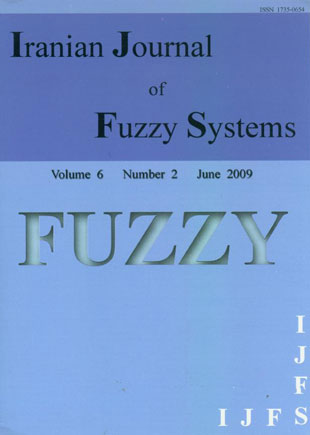فهرست مطالب

Iranian journal of fuzzy systems
Volume:6 Issue: 2, Jun 2009
- 98 صفحه،
- تاریخ انتشار: 1388/04/15
- تعداد عناوین: 7
-
-
Page 1Kim and Bishu (Fuzzy Sets and Systems 100 (1998) 343-352) proposed a modification of fuzzy linear regression analysis. Their modification is based on a criterion of minimizing the difference of the fuzzy membership values between the observed and estimated fuzzy numbers. We show that their method sometimes does not find acceptable fuzzy linear regression coefficients. To overcome this shortcoming, we modify their method. Finally, two numerical examples are solved in order to illustrate efficiency of the modified method
-
Page 7The aim of this paper is to extend to the non-commutative case some results established by H. Ono and T. Kowalski regarding directly indecomposable commutative residuated lattices. The main result consists of proving that a residuated lattice A is directly indecomposable if and only if its Boolean center B(A) is {0, 1}. We also prove that any linearly ordered residuated lattice and any local residuated lattice are directly indecomposable. As application of these results we prove some properties of the Boolean center of a residuated lattice and we define the algebras on subintervals of residuated lattices
-
Page 19In this paper, we define the concepts of compatibility between two fuzzy subsets on Q the set of states of a max- min general fuzzy automaton and transitivity in a max-min general fuzzy automaton. By using these notions, we construct a uniform structure on Q, and also introduce a topology on it. Then we define the concept of semi-uniform structure on a nonempty set X and by using this notion, we construct a semi-uniform structure on Q the set of states of a general fuzzy automaton. Also, we construct a semi-uniform structure on the set of all finite words on the set of input symbols of a general fuzzy automaton. Moreover by using these semi-uniform structures, we construct two topologies on Q and and obtain some properties of these topologies.
-
Page 31The notion of vague ideals in pseudo MV-algebras is introduced, and several properties are investigated. Conditions for a vague set to be a vague ideal are provided. Conditions for a vague ideal to be implicative are given. Characterizations of (implicative, prime) vague ideals are discussed. The smallest vague ideal containing a given vague set is established. Prime and implicative extension property for a vague ideal is discussed.
-
Page 47The aim of this paper is the study of fuzzy -hyperrings. In this regard the notion of -fuzzy hyperideals of -hyperrings are introduced and basic properties of them are investigated. In particular, the representation theorem for $\gama$-fuzzy hyperideals are given and it is shown that the image of a $\gama$-fuzzy hyperideal of a $\gama$ -hyperring under a certain conditions is two-valued. Finally, the product of $\gama$-fuzzy hyperideals are studied.
-
Page 61In this paper, at _rst we de_ne the notion of a complete general fuzzy automaton with threshold c, then we construct an H_- group on the set of states of a complete general fuzzy automaton with threshold c. Then we construct some commutative hypergroups on the set of states of a general fuzzy automaton. After that, we de_ne the concepts of invertible general fuzzy automata, homogeneous, separated, thresoldness connected, thresholdness in- ner irreducible, principal and strongly connected on an invertible general fuzzy automaton and by using these notions, we construct a quasi-order hypergroup on an invertible general fuzzy automaton. Finally, we obtain some relation- ships between the properties of an invertible general fuzzy automaton and the properties of the induced hypergroup.
-
Page 75Molodtsov [20] introduced the concept of soft set as a new mathematical tool for dealing with uncertainties that is free from the di_culties that have troubled the usual theoretical approaches. In this paper we apply the notion of soft sets by Molodtsov to the theory of Hilbert algebras. The notion of soft Hilbert (abysmal and deductive) algebras, soft subalgebras, soft abysms and soft deductive systems are introduced, and their basic properties are investigated. Relations between soft Hilbert algebras, soft Hilbert abysmal algebras and soft Hilbert deductive algebras are provided.

